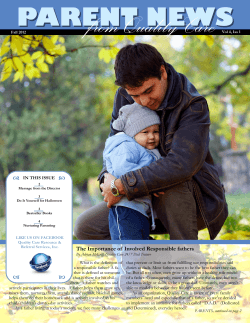
Why paternity leave matters for young children
www.fatherhoodinstitute.org Why paternity leave matters for young children CHILDREN DO BETTER AND ARE SAFER Swedish babies whose fathers take paternity leave are much more likely to be breastfed. Benefits include fewer infections. Fathers’ leave-taking (especially of 2+ weeks) is associated with more involvement in childcare. This is linked to better outcomes for children. Australian children whose fathers take longer-than-average leave perform better on IQ-type tests and are better prepared to start school. Increasing leave for mothers beyond 3-4 months does not, on average, result in improved cognitive outcomes for children. In Norway, when fathers are better-educated than their partners and take longer-than-average leave, girls do better in school. In Sweden, an increase in fathers’ share of parental leave countrywide over time was paralleled by a downward trend in children’s injury rates (age 0-4 years). In the UK, when fathers did not take paternity leave, their three-year-olds were more likely to have developmental problems. N.B. In many countries, fathers who take longer leave are less disadvantaged, but this only accounts for part of the positive effects FATHERS TAKE ON MORE CHILDCARE AND ARE MORE FAMILY-ORIENTED British fathers who take at least two weeks leave around the birth of their children are more involved in their children’s lives later on than fathers who took less leave. Israeli and US fathers who take longer leave remain more focused on and supportive of their infants, and place higher value on family life. Australian, Danish, UK & US fathers who take leave are more involved in feeding their babies, changing nappies, getting up in the night, bathing and reading to their children etc. afterwards. And leave-taking-Australianfathers are more likely to care for their babies by themselves on the weekend. In Sweden, fathers who take more leave are most satisfied with interactions with their children, and tend to work shorter hours than other fathers, once they return to work. FATHERS LIVE LONGER Swedish fathers who took paternity leave in the late 1970s have had an 18% lower risk of alcohol-related care and/or death than other fathers and a 16% overall reduced risk of early death. THEY DO IT : Between 1976 and 2006 paternity leave campaigns in Sweden featured men performing and talking about care work, in order to challenge traditional ideas of men and masculinity. However, because men were positioned as secondary rather than as primary parents, the campaigns undercut - rather than supported - a radical vision of gender equality. The early 2000s, however, saw a shift in the way fatherhood was represented in the campaigns. In contrast to earlier campaigns, men and women were given the same responsibility for parental leave — “Half each!” MOTHERS ARE HAPPIER, HEALTHIER AND EARN MORE When Norwegian fathers take longer leave, mothers’ sickness-related work absences are reduced by 5–10% from an average level of 20%. In France, when paternity leave results in greater father-involvement, new mothers are less likely to be depressed. Each additional month of parental leave taken by a father increases the mother’s earnings by 6.7%. PARENTS ARE HAPPIER TOGETHER AND SHARE HOUSEWORK Swedish couples are 30% less likely to separate if the father took more than two weeks’ leave. Norwegian families entitled to four weeks leave specially reserved for fathers experience an 11% reduction in conflict over household tasks and are 50% more likely to share the washing of clothes equally. Swedish fathers who took longer than average leave when their children were small, stay more involved in their lives after separation and divorce. To download other ‘Bringing fathers in’ resources and access relevant links and references, go to: www.fatherhoodinstitute.org/2014/bringing-fathers-inresources-for-advocates-practitioners-and-researchers/ Created with support from the Bernard van Leer Foundation
© Copyright 2025





















